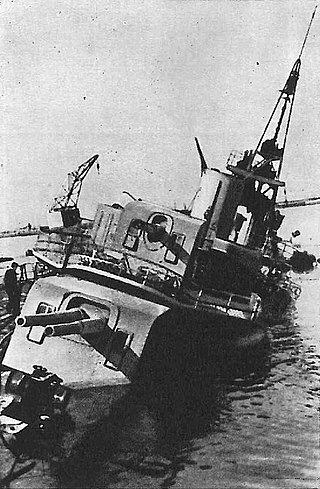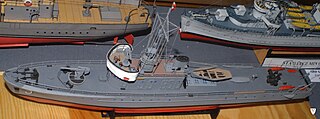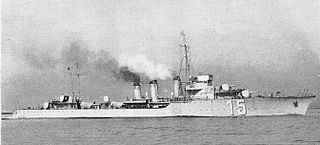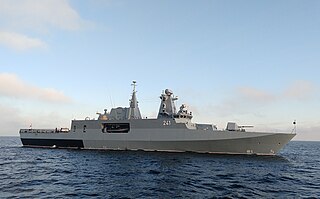
ORP Błyskawica is a Grom-class destroyer which served in the Polish Navy during World War II. She is the only Polish Navy ship to have been decorated with the Virtuti Militari, Poland's highest military order for gallantry, and in 2012 was given the Pro Memoria Medal. Błyskawica is preserved as a museum ship in Gdynia and is the oldest preserved destroyer in the world. Błyskawica is moored next to the Dar Pomorza.

ORP Orzeł was an Orzeł class submarine of the Polish Navy that served during WWII.

ORP Gryf was a large Polish Navy minelayer, sunk during the 1939 German invasion of Poland. She was one of two large Polish ships that were not evacuated to Great Britain during Operation Peking prior to the outbreak of the Polish Defensive War. She was sunk in Hel harbour on 3 September 1939 during the opening stage of World War II.

The Battle of Danzig Bay took place on 1 September 1939, at the beginning of the invasion of Poland, when Polish Navy warships were attacked by German Luftwaffe aircraft in Gdańsk Bay. It was the first naval-air battle of World War II.

ORP Wicher, the lead ship of the Wicher class, was a Polish Navy destroyer. She saw combat in the Invasion of Poland, which began World War II in Europe. She was the flagship of the Polish Navy, sunk by German bombers on 3 September 1939.

ORP Sokół was a U-class submarine built by Vickers-Armstrong at Barrow-in-Furness. Shortly after launching in September 1940 she was to be commissioned by the Royal Navy as HMS Urchin, but instead was leased to the Polish Navy due to a lack of experienced submarine crews. A sister boat to Dzik, both boats operated in the Mediterranean from Malta, where they became known as the "Terrible Twins".
This article details the order of battle of the Polish Navy prior to the outbreak of World War II and the Polish Defensive War of 1939. Following World War I, Poland's shoreline was relatively short and included no major seaports. In the 1920s and 1930s, such ports were built in Gdynia and Hel, and the Polish Navy underwent a modernisation program under the leadership of Counter-Admiral Józef Unrug and Vice-Admiral Jerzy Świrski. Ships were acquired from France, the Netherlands, and the United Kingdom, and the navy was to be able to secure the Polish supply lines in case of a war against the Soviet Union. By September 1939 the Polish Navy consisted of 5 submarines, 4 destroyers, and various support vessels and mine-warfare ships.

ORP Jaskółka was the lead ship of her class of minesweepers in the Polish Navy at the outset of World War II. Jaskółka was sunk during the Nazi invasion of 1939.

ORP Sęp was an Orzeł-class submarine serving in the Polish Navy during World War II. In Polish her name means Vulture.

The Battle of Hel was a World War II engagement fought from 1 September to 2 October 1939 on the Hel Peninsula, of the Baltic Sea coast, between invading German forces and defending Polish units during the German invasion of Poland. The defense of the Hel Peninsula took place around the Hel Fortified Area, a system of Polish fortifications that had been constructed in the 1930s near the interwar border with the German Third Reich.

Ouragan was a Bourrasque-class destroyer built for the French Navy during the 1920s. During World War II, the destroyer began the war in service with the French Navy and was undergoing repairs at Brest during the invasion of France. The British Royal Navy towed the destroyer to the United Kingdom and commandeered the vessel following the French surrender in 1940. They transferred Ouragan to the Polish Navy which kept the destroyer in service for less than a year. In 1941, the Polish Navy transferred the destroyer to the Free French Naval Forces, which in turn, transferred Ouragan back to the Royal Navy in 1943. Ouragan saw no further action and was broken up for scrap in 1949.

ORP Mazur was a torpedo boat, then gunnery training ship of the Polish Navy. She was the former German torpedo boat V-105. She took part in the Polish Defensive War and was sunk by German bombers on September 1, 1939, as the first combat ship lost in the war.

The Polish Navy is the naval branch of the Polish Armed Forces. The Polish Navy consists of 46 ships and about 12,000 commissioned and enlisted personnel. The traditional ship prefix in the Polish Navy is ORP.

ORP Ślązak (241) is an offshore patrol vessel of the Polish Navy, formerly known as Gawron-class corvette. The ship is named Ślązak. It is a licence variant of the MEKO A-100 project developed by Blohm + Voss.
Otto Bröhan was a German fishing trawler that was requisitioned by the Kriegsmarine in the Second World War for use as a Vorpostenboot, serving as V 207 Otto Bröhan and V 206 Otto Bröhan. She was scuttled at Caen, Calvados, France in June 1944. She was raised in March 1945 and converted to a survey ship for the French Navy, renamed Ingénieur Hydrographe Nicolas. She served until 1960 and was then scrapped.

ORP Nurek was a Polish diver depot ship from the interwar period and the beginning of World War II. Built at the Polish Navy Shipyard in Gdynia, it was commissioned in 1936 as a diver support and rescue and salvage ship, particularly for submarines. It participated in the construction of the ports in Hel and Władysławowo. The ship was bombed and sunk on September 1 in the Gdynia Naval Port; the wreck was salvaged by the Germans and scrapped.

ORP Kujawiak was a Polish A 56 type torpedo boat, served from 1921 to 1939; formerly the German A 68 from World War I, one of the first ships of the Polish Navy. The vessel was acquired by the navy from the division of Imperial German Navy ships after the end of the war. Struggling with technical issues, the unit served as a training ship from 1929, and then as an auxiliary ship, and was removed from the fleet list shortly before the outbreak of the war. During the Invasion of Poland, it served as a floating reserve oil tank, was sunk by aircraft, and subsequently scrapped.

ORP Smok was a full-sea tugboat of the Polish Navy, built in 1922 in La Rochelle, France. It sailed under various owners in France and Belgium under the names Le Boxeur and Leopold. Purchased by Poland in 1932, it served as a tugboat, training ship, and auxiliary mine-laying ship. It underwent numerous reconstructions. During the September Campaign, it transported materials from Gdynia to Hel. To block the entrance to the port in Hel, it was scuttled. It was salvaged by the Germans and, after repairs, incorporated into service under the name Rixhöft. It sailed until 1945, when it sank due to an aerial naval mine.

ORP Mewa is a Polish base minesweeper from the Cold War era, one of a series of 12 vessels of Projekt 206F, converted between 1998 and 1999 to a minehunter of Projekt 206FM. The unit measured 58.2 meters in length, 7.97 meters in width, and had a draft of 2.14 meters, with a full displacement of 470 tons. It was armed with three double sets of 25 mm 2M-3M autocannons and depth charges, and was also adapted for transporting and deploying naval mines.


















